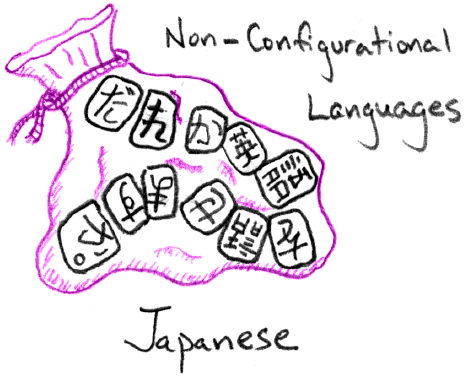old, then you don’t really understand it yourself. That got me thinking, and I’ve come to a couple of conclusions:
- According to my 10-year-old niece, I don’t understand any mathematical ideas.
- Something similar could be said for linguistic ideas.2
It is generally accepted that math is hard (Davis & Hersh, Friend, Lakoff & Núñez, Lucas, Mac Lane, Teen Talk)—and probably harder than linguistics (Friend, Lakoff & Núñez). So, we should be able to reduce the essence of important linguistic concepts to something we can explain to that bright, interested 10-year-old. In fact, I contend that we can boil the essence right down to something we can explain in a cartoon.3
As a first attempt at such a Cartoon Theory of Linguistics, I offer the following treatise on configurational and non-configurational languages:


Next time, we’ll look at ergativity.
References
“There is no such thing as the Queen’s English. The property has gone into
the hands of a joint stock company and we own the bulk of the shares!”
—Mark Twain
|
- Davis, Philip J., and Hersh, Reuben. (1981). The Mathematical Experience.
- Don & III. (1993). "Spaz Attack in the Corner." Speculative Grammarian, Vol. 147, No. 3.
- Filipepi, Alessandro. (1988). "Pictures of Lily." Psammeticus Quarterly, Vol. 16, No. 1.
- Friend, A. Mathematician. (2006). Personal communication.
- Hale, Kenneth L. (1980). "Remarks on Japanese phrase structure: Comments on the Papers on Japanese Syntax." In Y. Otsu & A. Farmer (Eds.), MIT Working Papers in Linguistics (Vol. 2).
- Hale, Kenneth L. (1982). "Preliminary remarks on configurationality." In J. Pustejovsky & P. Sells (Eds.), Proceedings of NELS 12 (pp. 86-96).
- Hale, Kenneth L. (1989). "On nonconfigurational structures." In L. Marácz & P. Muysken (Eds.), Configurationality: The Typology of Asymmetries (pp. 293-300).
- Lakoff, George, and Johnson, Mark. (1999). Philosophy in the Flesh.
- Lakoff, George, and Núñez, Rafael. (2000). Where Mathematics Comes From.
- Lucas, John Randolph. (2000). The Conceptual Roots of Mathematics.
- Mac Lane, Saunders. (1986). Mathematics: Form and Function.
- Marácz, L., & Muysken, P. (Eds.). (1989). Configurationality: The Typology of Asymmetries.
- Teen Talk, Barbie. (1994). Personal communication.
Notes
1 Not his real name.
2 That you should be able to explain it to a 10-year-old, not that I don’t understand any of them. Damn ambiguity.
3 As luck would have it, this has already been successfully attempted before. See Don & III, and Filipepi.


![]()
![]()
![]()